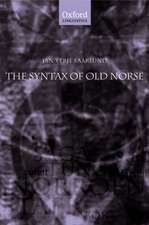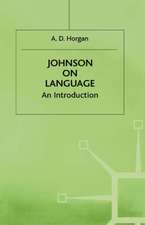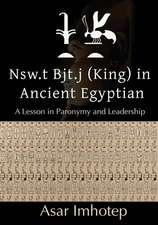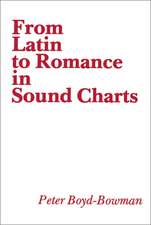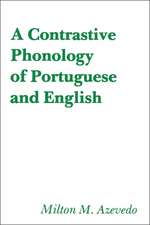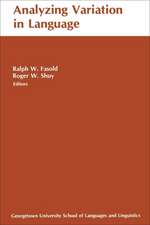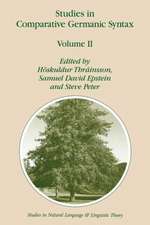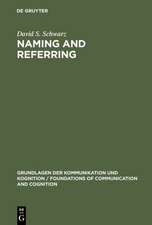The Tocharian Gender System: A Diachronic Study in Nominal Morphology: Brill's Studies in Indo-European Languages & Linguistics, cartea 25
Autor Alessandro Del Tombaen Limba Engleză Hardback – 19 apr 2023
Din seria Brill's Studies in Indo-European Languages & Linguistics
- 18%
 Preț: 808.20 lei
Preț: 808.20 lei - 18%
 Preț: 1348.18 lei
Preț: 1348.18 lei - 18%
 Preț: 1064.18 lei
Preț: 1064.18 lei - 18%
 Preț: 862.00 lei
Preț: 862.00 lei - 18%
 Preț: 783.05 lei
Preț: 783.05 lei - 18%
 Preț: 981.17 lei
Preț: 981.17 lei - 18%
 Preț: 735.42 lei
Preț: 735.42 lei - 18%
 Preț: 606.83 lei
Preț: 606.83 lei - 18%
 Preț: 639.22 lei
Preț: 639.22 lei - 18%
 Preț: 998.35 lei
Preț: 998.35 lei - 18%
 Preț: 981.21 lei
Preț: 981.21 lei - 18%
 Preț: 798.29 lei
Preț: 798.29 lei - 18%
 Preț: 1000.99 lei
Preț: 1000.99 lei - 18%
 Preț: 685.15 lei
Preț: 685.15 lei - 18%
 Preț: 654.93 lei
Preț: 654.93 lei - 18%
 Preț: 635.15 lei
Preț: 635.15 lei - 18%
 Preț: 1049.67 lei
Preț: 1049.67 lei - 18%
 Preț: 818.23 lei
Preț: 818.23 lei - 18%
 Preț: 895.70 lei
Preț: 895.70 lei - 18%
 Preț: 838.54 lei
Preț: 838.54 lei - 18%
 Preț: 806.99 lei
Preț: 806.99 lei - 18%
 Preț: 1354.42 lei
Preț: 1354.42 lei - 18%
 Preț: 916.89 lei
Preț: 916.89 lei
Preț: 897.91 lei
Preț vechi: 1095.01 lei
-18% Nou
Puncte Express: 1347
Preț estimativ în valută:
171.87€ • 186.75$ • 144.46£
171.87€ • 186.75$ • 144.46£
Carte disponibilă
Livrare economică 31 martie-14 aprilie
Preluare comenzi: 021 569.72.76
Specificații
ISBN-13: 9789004532885
ISBN-10: 9004532889
Pagini: 450
Dimensiuni: 155 x 235 mm
Greutate: 0.8 kg
Editura: Brill
Colecția Brill
Seria Brill's Studies in Indo-European Languages & Linguistics
ISBN-10: 9004532889
Pagini: 450
Dimensiuni: 155 x 235 mm
Greutate: 0.8 kg
Editura: Brill
Colecția Brill
Seria Brill's Studies in Indo-European Languages & Linguistics
Notă biografică
Alessandro Del Tomba, Ph.D. (2020) in Comparative Indo-European Linguistics (Leiden University) and Linguistics (Sapienza University of Rome), is currently Research Fellow at Sapienza University of Rome. He has published on Proto-Indo-European phonology, morphology, and morphosyntax, with a focus on Tocharian and Eastern Middle Iranian languages.
Cuprins
Preface and Acknowledgments
Abbreviations and Symbols
List of Tables
1 Introduction
1.1 Tocharian
1.2 Tocharian Grammatical Gender
1.3 Aim
1.4 Structure and Outline of the Book
2 The Gender System of Tocharian
A Synchronic and Typological Overview
2.1 Grammatical Gender: Methodological and Theoretical Background
2.2 The Gender System of Tocharian
2.3 The Gender Assignment System of Tocharian
2.4 The Gender System of Proto-Indo-European: State of the Art and Open Questions
2.5 Summary and Conclusions
3 Gender in the Inflection of the Noun
3.1 Tocharian Nominal Categories
3.2 Tocharian Noun Declension
3.3 Aim and Structure of the Chapter
3.4 Nouns Denoting Female Entities
3.5 Grammatical Gender and the Development of Inflectional Classes from class vi (nom.pl. -ñ)
3.6 The Evolution of the PIE Neuter in the Noun Inflection of Tocharian
3.7 Summary and Conclusions
4 Gender in the Inflection of the Pronoun and Adjective
4.1 General Aim, Methodology and Structure of the Chapter
4.2 Overview of the Tocharian Pronominal System
4.3 Evolution of the Tocharian Demonstrative Pronouns
4.4 Evolution of the Pronominal Adjective TB allek, TA ālak ‘other’
4.5 Conclusion
4.6 Overview of the Tocharian Adjectival System
4.7 Reconstruction of the Proto-Tocharian Adjectival Paradigms
4.8 Evolution of the Gender System: From Proto-Indo-European to Tocharian
5 Retrospective and Conclusion
5.1 Synchronic Analysis
5.2 Diachrony of the Masculine
5.3 Diachrony of the Feminine
5.4 Diachrony of the Genus Alternans
5.5 Outlook
Bibliography
Index Verborum
Abbreviations and Symbols
List of Tables
1 Introduction
1.1 Tocharian
1.2 Tocharian Grammatical Gender
1.3 Aim
1.4 Structure and Outline of the Book
2 The Gender System of Tocharian
A Synchronic and Typological Overview
2.1 Grammatical Gender: Methodological and Theoretical Background
2.2 The Gender System of Tocharian
2.3 The Gender Assignment System of Tocharian
2.4 The Gender System of Proto-Indo-European: State of the Art and Open Questions
2.5 Summary and Conclusions
3 Gender in the Inflection of the Noun
3.1 Tocharian Nominal Categories
3.2 Tocharian Noun Declension
3.3 Aim and Structure of the Chapter
3.4 Nouns Denoting Female Entities
3.5 Grammatical Gender and the Development of Inflectional Classes from class vi (nom.pl. -ñ)
3.6 The Evolution of the PIE Neuter in the Noun Inflection of Tocharian
3.7 Summary and Conclusions
4 Gender in the Inflection of the Pronoun and Adjective
4.1 General Aim, Methodology and Structure of the Chapter
4.2 Overview of the Tocharian Pronominal System
4.3 Evolution of the Tocharian Demonstrative Pronouns
4.4 Evolution of the Pronominal Adjective TB allek, TA ālak ‘other’
4.5 Conclusion
4.6 Overview of the Tocharian Adjectival System
4.7 Reconstruction of the Proto-Tocharian Adjectival Paradigms
4.8 Evolution of the Gender System: From Proto-Indo-European to Tocharian
5 Retrospective and Conclusion
5.1 Synchronic Analysis
5.2 Diachrony of the Masculine
5.3 Diachrony of the Feminine
5.4 Diachrony of the Genus Alternans
5.5 Outlook
Bibliography
Index Verborum



